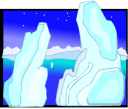Moving Geography: Antarctic Ice Shelf Breaks Up
Part 1: Recent Events In the news recently: A giant iceberg has broken off from its home for thousands of years in Antarctica. This might not sound like such big news, but it is part of a bigger trend and also an excellent example of geography on the move.
This iceberg, called Larsen B, was 650 feet thick and had a surface area of 1,250 square miles (about the size of Rhode Island). During a five-week period, it gradually broke off from the Larsen Ice Shelf, a massive piece of ice that has been around for 12,000 years.
What does this mean for us, other than that large icebergs are floating in the ocean? Well, it's not what happens today that counts but what will happen tomorrow. Those icebergs will eventually reach warmer water and melt. This will create more water. More water on Earth means that countries like the Netherlands, most of which is below sea level, will have a more difficult time keeping the sea at bay. It also means that waves and hurricanes will be bigger, something that everyone on America's East Coast can understand. Next page > Global Warming > Page 1, 2, 3 |
|
Social Studies for Kids
copyright 2002–2024
David White



 First,
the trend: It's called global warming. Earth is gradually
getting warmer. It's not a whole lot at a time, though, but
something more like fractions of a degree every year.
However, those fractions add up over time. And the warmer
Earth gets, the more ice melts and the more icebergs break
off from polar ice caps and start roaming the planet.
First,
the trend: It's called global warming. Earth is gradually
getting warmer. It's not a whole lot at a time, though, but
something more like fractions of a degree every year.
However, those fractions add up over time. And the warmer
Earth gets, the more ice melts and the more icebergs break
off from polar ice caps and start roaming the planet.
 Another
large part of the Shelf, Larsen A, broke off in 1995.
Another
large part of the Shelf, Larsen A, broke off in 1995.

